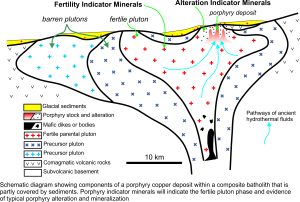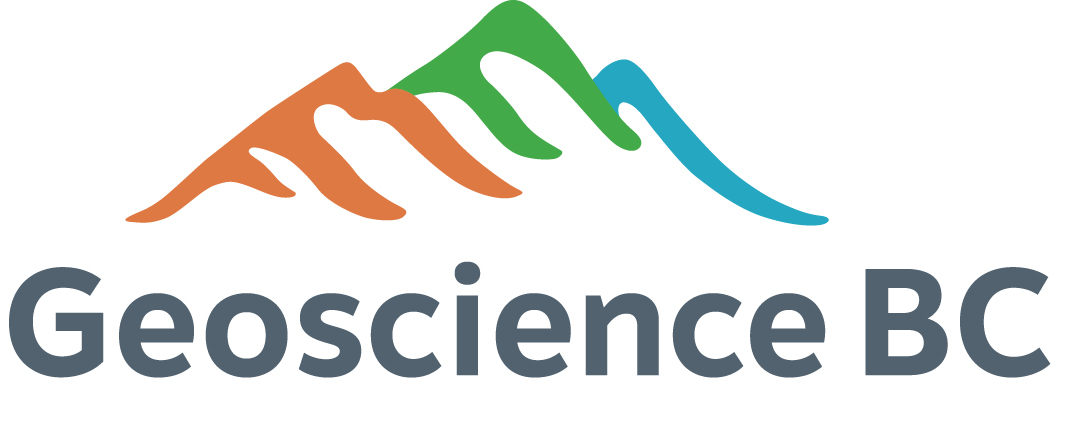Project Information
- Ore Deposit: Porphyry
- Commodity: Copper, Gold
- Research Themes: Copper, Exploration Methods
- Location: British Columbia, Canada
- Project Status: Completed
- Start Date: 2015
- End Date: 2018
Exploration for porphyry copper deposits is mostly focused on following-up on alteration patterns or empirical geochemical or geophysical data, which are ineffective in areas of cover, such as glacial till or regolith. Distinguishing porphyry-fertile from barren plutons in the earliest stages of exploration could provide a significant advantage by immediately identifying those plutons that had the potential to form porphyry copper deposits. This study identifies the mineralogical and geochemical characteristics of porphyry fertile plutons and develops exploration tools that allow for the identification of such plutonic bodies.
Distinguishing metal fertile from barren plutons is a significant challenge for exploration geologists seeking porphyry copper deposits. Information that contributes such a priori knowledge provides guidance early in the exploration process to more effectively and efficiently make decisions on focusing exploration resources on more prospective targets. However, geologists do not have access to such tools that can effectively identify features of enhanced fertility and prospectivity. The most fundamental process in porphyry copper deposit formation is the exsolution of metal-rich magmatic hydrothermal fluids in large crystallizing batholiths below the site of porphyry copper deposit formations. These buoyant fluids stream through the crust to form perched porphyry copper deposits, but in many districts large porphyry deposits are hosted directly within or adjacent to the large causative plutons. In all cases, these plutons will host evidence that record these processes of porphyry fertility. The characterization of fertility in British Columbia has many benefits since many porphyry systems occur within or around the edges of large batholiths, or are in systems that have been tilted such that the deeper plutonic parts of the system are well-exposed.

This project, supported by Geoscience BC, identifies field, mineralogical and geochemical characteristics of porphyry fertile plutons and develops exploration tools for the subsequent identification of fertile plutonic terrains of British Columbia. Physical and chemical features in common accessory minerals, e.g., apatite, titanite, that show evidence of magmatic processes such as high oxidation state, evidence of fluid saturation, magma fertilization by mafic melt injection, and sulphate saturation and depletion in the melt are characterized.
IMPACTS:
- Determined the mineralogical features that characterize and distinguish porphyry fertile intrusions.
- Assessed features and geochemistry of apatite and titanite that indicate fertility.
- Document fertility evidence over time and space within an evolving composite zoned pluton.
- Assessed the utilization of rapid, mineralogical characterization tools.
- Constructed a toolkit to provide a predictive decision-making framework to assess fertility in rocks, stream sediment and till heavy mineral concentrates.
Final Report
 Bouzari, F., Hart, C.J.R., Bissig, T. and Lesage, G., 2018. Mineralogical and Geochemical Characteristics of Porphyry-Fertile Plutons: Guichon Creek, Takomkane and Granite Mountain Batholiths, south-central British Columbia (NTS 092I, P; 093A, B). Geoscience BC Report 2018-17. MDRU Publication 412 – 36p. Download PDF report 23 Mb
Bouzari, F., Hart, C.J.R., Bissig, T. and Lesage, G., 2018. Mineralogical and Geochemical Characteristics of Porphyry-Fertile Plutons: Guichon Creek, Takomkane and Granite Mountain Batholiths, south-central British Columbia (NTS 092I, P; 093A, B). Geoscience BC Report 2018-17. MDRU Publication 412 – 36p. Download PDF report 23 Mb
Interim Reports and Posters
Bouzari, F., Hart, C.J.R., Bissig, T. and Lesage, G., 2017. Mineralogical and geochemical characteristics of porphyry-fertile plutons: Guichon Creek, Takomkane and Granite Mountain batholiths, south-central British Columbia (NTS 092I, P, 093A, B); in Geoscience BC Summary of Activities 2016, Geoscience BC, Report 2017-1, p. 189–200. Download PDF report 4 Mb
Bouzari, F., Hart, C.J.R., Bissig, T. and Lesage, G., 2016. Mineralogical and geochemical characteristics of porphyry-fertile plutons: Guichon Creek, Takomkane and Granite Mountain batholiths, south-central British Columbia; in Geoscience BC Summary of Activities 2015, Report 2016-1, p. 17–22. Download PDF report 2 Mb
Bouzari, F., Hart, C.J.R., Bissig, T. and Lesage, G., 2016. Mineralogical and geochemical characteristics of porphyry-fertile plutons: Guichon Creek, Takomkane and Granite Mountain Batholiths, south-central British Columbia: evidence from apatite. Poster. Presented at Exploration RoundUp January 2016, Vancouver, Canada. Download PDF poster 6 Mb
Contact Farhad Bouzari for more information.




